1. Manicured lawns produce more greenhouse gases than they soak up
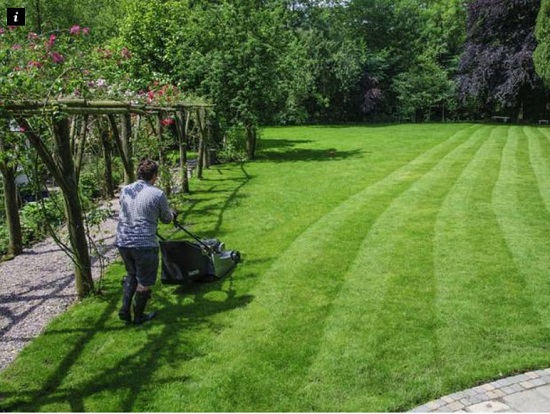
Researchers found:
that a hectare of lawn in Nashville, Tennessee, produced greenhouse gases equivalent to 697 to 2,443kg of carbon dioxide a year. The higher figure is equivalent to a flight more than halfway around the world.
If you use a mulching mower, don’t fertilise, limit cutting and watering, you might tip the balance in favour of the planet. But then your lawn might not be as lush.
2. Risk of extreme climate outcomes
Across the ditch Hot Topic takes a look at a new book by economists Gernot Wagner and Martin Weitzman called Climate Shock: The Economic Consequences of a Hotter Planet. They start with the notion that climate stabilisation forecasts regularly show that there is a 10% chance of warming reaching 6°C or more. Although not talked about much, this is standard fare and can be read off this graph I have posted multiple times:
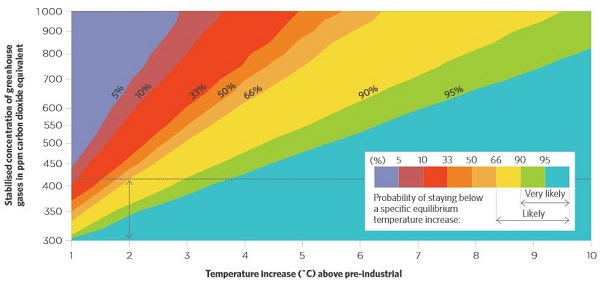
The 10% chance of reaching 6°C comes with greenhouse gases (CO2e) at around 580 ppm. We are currently at 480 ppm.
The whole insurance industry is predicated on probabilities of considerably less than 10%. The authors are suggesting that low probability extreme events should be taken seriously by governments. A 10% chance of climate Armageddon is not particularly low.
Weitzman was on the case back in 2008, when I did a post on him at LP, unfortunately in a gap in the archive. Peter Wood did a submission to the Garnaut Report on the subject. Garnaut, it must be said, looked the other way.
3. Arctic sea ice excitement
There has been some excitement over Arctic sea ice extent. As of now, unless there is a peak in late March, which is possible, the winter maximum is looking like a record low. This picture simplifies the story:
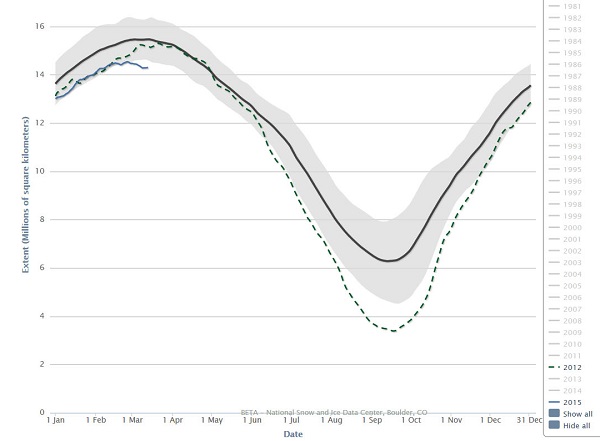
It shows 2012 and 2015 ice extent against the 1981-2010 average. In the short term ice can be compacted by storms, or flushed out through Fram Strait. A cold snap can extend the ice with a thin cover. Also, as we see in 2012, winter maximums tell you nothing about summer minimums.
That’s the short story. You can read more here, here, here and here.
4. Greenland melting speeds up
As scientists upgrade their models of ice sheet decay, Greenland has a habit of exceeding their expectations.
According to the Intergovernmental Panel on Climate Change, Greenland ice loss has increased a phenomenal 632 percent since 2001. (14) This increase is coming from melt, sublimation (ice evaporating directly without melting first), melt penetrating to the bottom of the ice sheet through crevasses and moulins, and from rapidly warming Arctic Ocean waters penetrating beneath floating outlet glaciers, destabilizing these glaciers and increasing their flow.
Massive gorges have been found beneath the ice where rapidly warming seawater has the chance to circulate deep beneath the ice sheet.
A large aquifer has been found under the ice above sea level.
Soot forms on the ice from as far away as Siberia. As the ice sublimates, that is evaporates directly into the air, the soot remains to further decrease reflectivity.
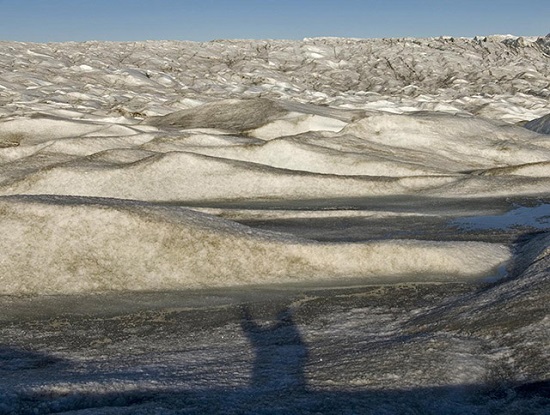
The knowns and the known unknowns add up to a pretty grim picture.
Commendable progress is being made on renewable energy in Europe.
Renewables contribute 26% of EU electricity, 17% of heating and cooling and 5% of transport, … It’s generally thought to be easier to decarbonise the electricity sector than heating or transport, where oil and gas continue to dominate.
This chart refers to electricity:
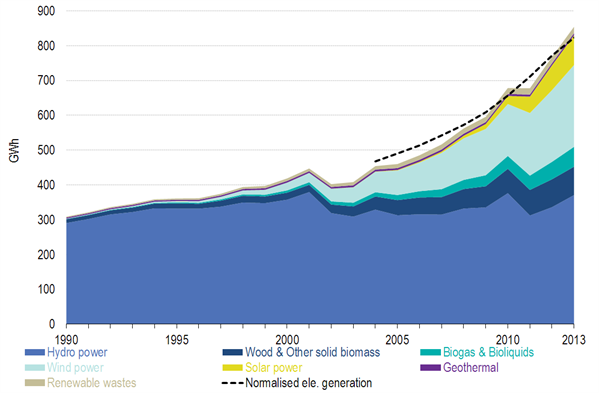
Apart from hydro, wind (light blue) easily eclipses solar (yellow).
When heating and transport are included, renewables comprise 20% of all energy, and the composition changes dramatically:
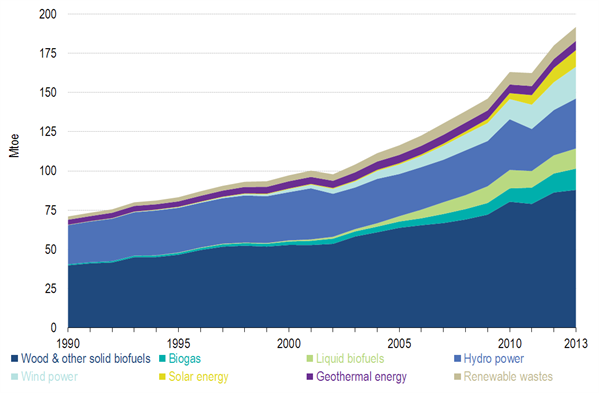
An old technology, renewable wood, easily dominates through selective forestry.
In recent times energy usage has fallen, with the EU now using as much energy as it did in 1990.
The UK is the biggest laggard in meeting individual country targets. Four countries, Sweden, Estonia, Lithuania and Bulgaria, are ahead of target.
Wind has the momentum in the US with forecasts that it could supply 35% of electricity by 2050, or even as much as 41%. Within 10 years wind could be cheaper than existing coal.
6. 90% of Australian coal plants ‘at risk’ of being stranded assets
Oxford University’s Smith School of Enterprise and the Environment has compiled a Stranded Assets Programme report.
It is food for thought for Australia, then, that the Oxford report has declared it owner of “by far” the most carbon-intensive sub-critical fleet in the world (followed by India and Indonesia), with a whopping 90 per cent of its total 29GW of coal-fired generation capacity coming from 23 subcritical plants.
From The Guardian:
Coal currently provides 40% of the world’s electricity and three-quarters of this is produced by the most-polluting, least-efficient and oldest “sub-critical” coal-fired power stations. The International Energy Agency calculates that one in four of these sub-critical plants must close within five years, if the world’s governments are to keep their pledge to limit global warming to 2C.
Help is at hand, according to a group of Queensland engineers.
The Callide Oxyfuel Project is one of just a few low-emission coal projects in the world, and demonstrates how carbon capture technology can be retrofitted to existing power stations.
The technique has been on trial at CS Energy’s Callide A coal-fired power station at Biloela, in a project worth $245 million.
They reckon they’ve done it on a 30-megawatt plant and now need to scale it up. Predictably, not everyone agrees it’s worthwhile.
Global energy-related CO2 emissions flatlined last year, according to the IEA.
Following an announcement earlier this week that China’s CO2 emissions fell 2 percent in 2014, the IEA is crediting 2014’s progress to China using more solar, wind and hydropower while burning less coal. Western Europe’s focus on sustainable growth, energy efficiency and renewables has shown that emissions from energy consumption can fall even as economies grow globally, according to the IEA.
Global CO2 emissions stalled or fell in the early 1980s, 1992 and 2009, each time correlating with a faltering global economy. In 2014, the economy grew 3 percent worldwide.
The story is about energy efficiency as well as growth of renewables. Cheaper fossil fuels could lead to a resumption of fossil fuel growth in 2015, however.


Thanks Brian.
There’s a little bit of “scary big numbers” syndrome in the first item. Apart from the very large uncertainty in the figures, one hectare is 10000m2, when suburban manicured lawns would be about 50m2 these days at a conservative guess. So one family’s perfectly manicured lawn is about 1/200th of a flight halfway around the world!
Even so, any excuse to stop mowing my lawns is appreciated!
It’s a pleasure, BilB.
wilful, you are absolutely right. It did occur to me, and I was a bit surprised they didn’t use acres.
While the earth moves into accelerated heating the Delusionati of JoNova and elsewhere are desperately attempting to discredit Climate Scientists. Even the Royal Society has its deluded agents of denial. A group of 43 “fellows” (curiously 43 of 1430 fellows or just 3% against 97%) attempted to destabalise the Society’s Climate Science solidarity with a letter in 2010 demanding that the Society abandon conviction and embrace doubt and skepticism. Now these climate action obstructionists are attempting to revive their failed attempt
http://wattsupwiththat.com/2012/02/28/cambridge-professor-michael-kelly-on-deniers-and-climate-change-science-has-been-consistently-over-egged-to-produce-alarm/
..while at the same time regain credibility and shed the “denialist” patch. It is worth reading Kelly’s protestations.
…conviction….
[Fixed – Brian]
BilB: I do like your “Delusionati”. How apt.
All: For the life of me, I just cannot understand the irrational opposition to sustainable practices and to reduced energy consumption. Being sustainable and reducing energy consumption makes social, economic and environmental sense.
Re No. 6: Since stranded assets is such a serious problem, why the blue blazes do we not have a Minister for Stranded Assets? The title may offend some but that can be jiggled around until a nicer sounding title is whipped up. We have had ministers for this, that and the other created at the drop of a hat – yet no Minister for Stranded Assets. Yeah, I know: if a problem is ignored strenuously enough it will simply vanish in a puff of smoke, won’t it?
The Callide Oxyfuel Project might be quite useful as a transitional and limited-duration technology.
One thing nobody seems to have noticed is that we are burning up as fuel what is potentially tens-of-thousands of years of high-grade, easily-accessible carbon feedstock.
Thanks, GB. The term popped into my head mid afternoon but i could not remember what the “ati” was party of, but once I finally remembered the Illuminati and researched what they we originally about, Delusionati was so perfectly what Monckton’s minions are all about.
And I thought that it was very appropriate that Brian’s blog should be the place to where the coining of the term should first appear.
So please use it, fire at will.
Thanks, BilB. Have loaded 20 rounds of Delusionati into my conversational magazine and look forward to firing them off in a few bursts of rapid fire. Don’t think It will change the minds of the obsessives and the wilfully ignorant – but one can only try …. 🙂
GB: We don’t actually need fossil carbon feedstock. If you have clean energy you can produce carbon feedstock using the CO2 disolved in water (Or any other source of CO2 for that matter.) Iceland is using renewable energy + CO2 from its volcanic fields to produce renewable methanol. Methanol can be used as the starting point for producing a wide range of hydrocarbons.